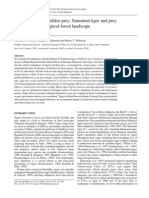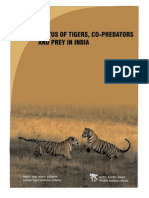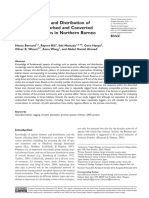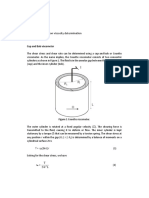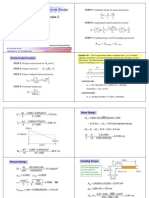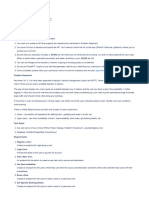First Estimates of Primate Density and Abundance in Siberut National Park, Mentawai Islands, Indonesia
First Estimates of Primate Density and Abundance in Siberut National Park, Mentawai Islands, Indonesia
Uploaded by
arim029Copyright:
Available Formats
First Estimates of Primate Density and Abundance in Siberut National Park, Mentawai Islands, Indonesia
First Estimates of Primate Density and Abundance in Siberut National Park, Mentawai Islands, Indonesia
Uploaded by
arim029Original Title
Copyright
Available Formats
Share this document
Did you find this document useful?
Is this content inappropriate?
Copyright:
Available Formats
First Estimates of Primate Density and Abundance in Siberut National Park, Mentawai Islands, Indonesia
First Estimates of Primate Density and Abundance in Siberut National Park, Mentawai Islands, Indonesia
Uploaded by
arim029Copyright:
Available Formats
Short Communication
First estimates of primate density and abundance in
Siberut National Park, Mentawai Islands, Indonesia
M A R C E L C . Q U I N T E N , F I F I N N O P I A N S Y A H and J . K E I T H H O D G E S
Abstract In we carried out the first systematic survey to the IUCN Red List (IUCN, ). The pig-tailed langur is
determine the density and abundance of endemic forest pri- among the most threatened primates (Mittermeier
mates in Siberut National Park, in the Mentawai Islands of et al., ).
West Sumatra, Indonesia. Distance sampling was employed Regardless of their conservation status, there is a dearth
to survey transects located systematically throughout the of reliable information on the size of the region’s primate
Park, yielding a total survey effort of km and obser- population, which is essential for effective management
vations of primates for data analysis. From density estimates and conservation planning. The few publications that have
for the four resident primate species, the Siberut langur presented population estimates for the Mentawai Islands are
Presbytis siberu, the pig-tailed snub-nosed langur Simias typically species-specific (e.g. Tilson, ; Whittaker, )
concolor, Kloss’s gibbon Hylobates klossii and the Siberut and/or base their estimates on geographically restricted data
macaque Macaca siberu, we extrapolated a total population (e.g. Waltert et al., ; Quinten et al., ). Significantly,
of c. , primates within the Park. We conclude that there is a lack of data from the archipelago’s only protected
Siberut National Park is of major significance for the contin- area, Siberut National Park, located on the largest and
ued survival of Siberut’s endemic primates, and provide re- northernmost of the four islands. Formally declared in
commendations to help ensure that it will continue to , the Park covers .% of Siberut (Fig. ) and comprises
function as a refuge for primates. predominantly evergreen primary lowland rainforest
(.%; M. Quinten, unpubl. data). Unlike many of
Keywords Hylobates klossii, line-transect survey, Macaca
Indonesia’s protected areas, Siberut National Park was de-
siberu, Mentawai Islands, population density, Presbytis si-
signed to contain human settlements. It is subdivided into
beru, Siberut National Park, Simias concolor
three land-use zones (sanctuary, traditional use and park
village) and there are at least , inhabitants in the park
village zone (PHPA, ), which is the least restricted. As
T he Mentawai Island primates are a unique community
of sympatrically occurring, endemic species of the
c. , km (BPS, ) Mentawai Archipelago in West
with many government-established parks and reserves, pro-
tection and enforcement within the Park are hampered by
Sumatra, Indonesia. On the four main islands (Siberut, staff members’ lack of knowledge and training in wildlife
Sipora, North Pagai and South Pagai) six species (Roos ecology and conservation management, and by insufficient
et al., ) coexist: the Siberut macaque Macaca siberu, funding. Thus, despite its .-year history and its potential
the Pagai Island macaque Macaca pagensis, the Siberut lan- importance as a refuge for primates, no systematic surveys
gur Presbytis siberu, the Pagai langur Presbytis potenziani, have been carried out within the Park boundaries and
the pig-tailed snub-nosed langur Simias concolor, and consequently no data on primate density and abundance
Kloss’s gibbon Hylobates klossii. Threatened mainly by are available.
anthropogenic hunting and habitat loss (commercial log- Following on from surveys of primates in the north of the
ging, agriculture), all six species are considered to be in de- island, outside the National Park (Waltert et al., ;
cline (Whittaker, ). They are categorized as Vulnerable Quinten et al., ), the Siberut Conservation
(M. siberu), Endangered (P. siberu (as P. potenziani siberu) Programme established a collaboration with the Siberut
and H. klossii) or Critically Endangered (P. potenziani (as National Park Authority, Green Siberut Association, and
P. potenziani potenziani), M. pagensis and S. concolor) on UNESCO to carry out surveys within the Park. Our aims
were to provide the first systematic and reliable estimates
of primate density and abundance in the Park, extend the
MARCEL C. QUINTEN (Corresponding author) and J. KEITH HODGES Reproductive existing dataset on primate population sizes in the
Biology Unit, German Primate Center, Kellnerweg 4, Goettingen 37077, Mentawai Islands, and provide training in primate survey
Germany, and Siberut Conservation Programme, Pola Mas, Padang 25122,
Indonesia. E-mail marcel.quinten-dpz@gmx.de
methodology and data analysis for staff of the National
Park Authority and affiliated organizations in the region.
FIFIN NOPIANSYAH Siberut National Park Office, Padang, West Sumatra,
Indonesia We organized a -day workshop (− May ), dur-
Received August . Revision requested November .
ing which participants received in-depth training in theor-
Accepted December . etical (e.g. survey design, general methodology) and
© 2015 Fauna & Flora International, Oryx, Page 1 of 4 doi:10.1017/S0030605314001185
http://journals.cambridge.org Downloaded: 31 Mar 2015 IP address: 138.5.159.110
2 M. C. Quinten et al.
primate observations by transect, and analysed each species
separately using both visual and acoustic observations. We
truncated the data to estimate the detection function g(x)
and the cluster (group) size (Table ); we determined cluster
size using the size bias regression method, regressing ln(clus-
ter size) against the estimated g(x).
By surveying all transects – times we achieved a total
survey effort of km, yielding detection events for the
four primate species on Siberut (Table ): S. concolor (),
M. siberu (), P. siberu () and H. klossii (). Presbytis si-
beru was the most abundant primate, and based on a density
of c. . individuals per km (c. . clusters per km) we
estimate the total population in the Park to be , indi-
viduals. We modelled a density of . individuals per km
(c. . clusters per km) and a total population of c. ,
individuals for Siberut’s other colobine, S. concolor. The es-
timated densities of H. klossii and M. siberu were . and
. individuals per km (c. . and c. . clusters per km),
respectively, yielding population estimates of c. , gib-
bons and , macaques (Table ). Collectively, this indi-
cates a population of c. , primates within the Park.
However, as our survey transects were located almost ex-
clusively in primate habitat (e.g. primary and swamp forest),
leaving non-suitable habitat underrepresented (c. –% of
the Park area, including bare land and agricultural areas;
M. Quinten, unpubl. data), this number may represent a
slight overestimation.
FIG. 1 Locations of closed-circuit transects, within a Given that no other systematic survey of primates has
systematic-random sampling grid, used to survey the four been conducted in Siberut National Park we cannot com-
endemic primate species in Siberut National Park in the pare our results with earlier information, or comment on
Mentawai Islands, Indonesia. The rectangle on the inset indicates population changes over time. A comparison with the
the location of the main map in Indonesia.
only available population estimates for the whole island
(Whittaker, , largely based on WWF, ; Table ),
practical (e.g. equipment handling, transect cutting) aspects however, suggests that a substantial proportion of the popu-
of primate population surveys. We then assigned successful lations of all four primate species occurs within the Park,
participants to one of seven teams and sent them to the field emphasizing its conservation importance for the region’s
to conduct distance sampling surveys (Buckland et al., , primates. It also indicates that P. siberu and S. concolor are
) of primates at two or three of a total of closed- considerably more abundant on Siberut than Whittaker
circuit transects (length per transect , m), located ac- () suggested (our estimates for the Park are c. .–
cording to a random vector grid (Fig. ). The survey design times higher than those of Whittaker for the entire island).
represented the best possible solution taking into account Given the Park’s comparatively high abundance of pri-
logistical difficulties (no roads, remoteness, difficult terrain) mates, and considering that () the Park covers almost
and available resources (time, manpower, budget). half of Siberut Island, () the areas outside the Park are lar-
All teams conducted daily survey walks during times of gely production and conversion forest, and () there is little
peak primate activity (c. .–. and .–.), and remaining forest (and thus primate habitat) on the three
recorded standard survey data (cf. Quinten et al., ). southern Mentawai Islands, we conclude that Siberut
Using a laser range finder, perpendicular distances were National Park represents the most important habitat for pri-
measured from the transect line to the centre of all counta- mates in the Mentawai region. To successfully fulfil its func-
ble individuals of each primate cluster; when primates were tion as a refuge, the Park administration will need to address
detected acoustically the perpendicular distance to the esti- two main challenges. Firstly, encroachment associated with
mated location was measured. All teams returned to main- human population growth (cf. PHPA, ) continues to
land Sumatra in June to attend a workshop, where we have a negative impact on primate populations in the
analysed all data using DISTANCE v. . (Thomas et al., Park, principally in terms of habitat loss and hunting
). For this purpose we pooled individual surveys and (Quinten et al., ). Secondly, inadequate funding and
© 2015 Fauna & Flora International, Oryx, 1–4
http://journals.cambridge.org Downloaded: 31 Mar 2015 IP address: 138.5.159.110
© 2015 Fauna & Flora International, Oryx, 1–4
TABLE 1 Species-specific survey results for the primates inhabiting Siberut National Park, Indonesia (Fig. ), and previous estimates for Siberut Island as a whole (Whittaker, ), with the
analysis parameters, mean encounter rate, size and density of primate clusters, detection probability, mean density estimate for individuals, and estimated population.
Pig-tailed langur Siberut macaque Mentawai langur Kloss’s gibbon
Simias concolor Macaca siberu Presbytis siberu Hylobates klossii
Analysis parameters*
c (m) 50 62 60 56
w (m) 115 94 100 93
nt 52 79 95 59
na 48 43 77 49
nvisual/acoustic 45/3 32/11 62/15 41/8
Analysis results
Mean encounter rate for clusters, km−1 (95% CI) 0.25 (0.17–0.38) 0.22 (0.13–0.39) 0.40 (0.28–0.57) 0.26 (0.17–0.39)
Mean cluster size (95% CI) 3.0 (2.4–3.8) 3.2 (2.2–4.6) 2.4 (2.0–2.8) 2.7 (2.1–3.4)
Mean cluster density, km−2 (95% CI) 2.8 (1.3–4.6) 1.8 (1.0–3.2) 4.4 (2.9–6.8) 2.4 (1.5–3.8)
Detection probability (95% CI) 0.38 (0.28–0.51) 0.68 (0.52–0.89) 0.46 (0.34–0.61) 0.58 (0.45–0.74)
Mean density, individuals km−2 (95% CI, CV) 8.5 (5.0–14.5, 27.2) 5.6 (2.8–11.1, 35.2) 10.4 (6.6–16.5, 23.1) 6.3 (3.7–10.6, 26.5)
Estimated population size (range), Siberut National Park 14,112 (8,252–24,133) 9,248 (4,639–18,438) 17,384 (11,014–27,439) 10,484 (6,206–17,713)
Results of Whittaker (2005)
Estimated population size (range), Siberut Island 10,750 (6,000–15,500) 23,500 (17,000–30,000) 5,550 (1,600–9,500) 19,500 (18,000–21,000)
*c, truncation distance for cluster size estimation; w, truncation distance for density estimation; nt, total number of observed clusters; na, number of clusters used for data analysis after truncation; nvisual/acoustic, ratio of
visual versus acoustic observations
Primates in Siberut National Park
3
http://journals.cambridge.org Downloaded: 31 Mar 2015 IP address: 138.5.159.110
4 M. C. Quinten et al.
levels of training in wildlife management, together with a B U C K L A N D , S.T., P L U M P T R E , A.J., T H O M A S , L. & R E X S T A D , E.A.
fragile relationship between the Park authorities and some () Design and analysis of line transect surveys for primates.
International Journal of Primatology, , –.
of its resident communities, compromise the effectiveness
IUCN () IUCN Red List of Threatened Species v. .. Http://
of the Park in achieving its conservation objectives. www.iucnredlist.org [accessed August ].
We advise the Indonesian Ministry of Forestry to in- M I T T E R M E I E R , R.A., S C H W I T Z E R , C., R Y L A N D S , A.B., T AY LO R , L.A.,
crease funding for the Park, to ensure adequate human re- C H I O Z Z A , F., W I L L I A M S O N , E.A. et al. (eds) () Primates in Peril:
sources to support the enforcement of its statutes on a local The World’s Most Endangered Primates –. IUCN/SSC
Primate Specialist Group, International Primatological Society,
level and to improve staff training in conservation manage-
Conservation International & Bristol Conservation and Science
ment. Greater emphasis needs to be placed on outreach ac- Foundation, Bristol, UK.
tivities to foster closer interaction and cooperation between PHPA () Siberut National Park Integrated Conservation and
Park management and the resident communities, raising Development Management Plan (–). Volume I: Current
local awareness of the value of Siberut’s rainforest habitat Conditions and Evaluation. Chemonics International in association
and the importance of a sustainable approach to resource with PT. Indeco Duta Utama and PT. Nadya Karsa Amerta, for
Ditjen Perlindungan Hutan dan Pelestarian Alam, Departemen
utilization. Finally, we recommend that further research Kehutanan, Jakarta, Indonesia.
be carried out, specifically () studies to examine the socio- Q U I N T E N , M.C., S T I R L I N G , F., S C H WA R Z E , S., D I N AT A , Y. & H O D G E S ,
economic needs of the Park’s inhabitants, and assess their J.K. () Knowledge, attitudes and practices of local people on
impact on the land, () time-series land-cover assessments Siberut Island (West-Sumatra, Indonesia) towards primate hunting
to determine rates of deforestation/habitat loss, and () and conservation. Journal of Threatened Taxa, , –.
Q U I N T E N , M.C., W A LT E R T , M., S Y A M S U R I , F. & H O D G E S , J.K. ()
long-term monitoring of population trends in the Park
Peat swamp forest supports high primate densities on Siberut Island,
(with surveys every – years); ideally this would be comple- Sumatra, Indonesia. Oryx, , –.
mented by surveys outside the Park in Siberut’s production R O O S , C., B O O N R AT A N A , R., S U P R I AT N A , J., F E L LO W E S , J.R., G R O V E S ,
forest/timber concessions. C.P., N A S H , S.D. et al. () An updated taxonomy and
conservation status review of Asian primates. Asian Primates
Journal, , –.
Acknowledgements T H O M A S , L., L A A K E , J.L., R E X S TA D , E., S T R I N D B E R G , S., M A R Q U E S , F.
F.C., B U C K L A N D , S.T. et al. () Distance .. Release . Research
We thank all partners (the Siberut National Park Authority, Unit for Wildlife Population Assessment, University of St. Andrews,
the Siberut Conservation Programme, Green Siberut St. Andrews, UK. Http://www.ruwpa.st-and.ac.uk/distance/
[accessed August ].
Association, and UNESCO) for their invaluable efforts in
T I L S O N , R.L. () Social organization of Simakobu monkeys (Nasalis
planning, coordinating and funding the project, specifically concolor) in Siberut Island, Indonesia. Journal of Mammalogy, ,
Mr Jusman, Ms Pio, Ms Acha De La Presa and Dr –.
Matthias Waltert. We thank the Rufford Foundation, the W A LT E R T , M., A B E G G , C., Z I E G L E R , T., H A D I , S., P R I A TA , D. &
Mohamed bin Zayed Species Conservation Fund and the H O D G E S , J.K. () Abundance and community structure of
Mentawai primates in the Peleonan forest, north Siberut, Indonesia.
Spanish Agency for International Cooperation for financial
Oryx, , –.
support, and the Indonesian Institute of Sciences for provid- W H I T TA K E R , D.J. () New population estimates for the endemic
ing the necessary research permits. Finally, we thank the Kloss’s gibbon (Hylobates klossii) on the Mentawai Islands,
members of the dedicated survey teams who made this Indonesia. Oryx, , –.
project possible, including the National Park employees W H I T TA K E R , D.J. () A conservation action plan for the Mentawai
primates. Primate Conservation, , –.
Ridho, Dedet, Kusmiadi, Efrinaldi, Matheus and Badul,
WWF () Saving Siberut: A Conservation Master Plan. WWF
the Green Siberut Association staff Yoyok and Silvanus, Indonesia Programme, Bogor, Indonesia.
the SMILE-team Fabianus, Ronal and Hamdi, Bogor
Agricultural University students Dani and Yandhi,
Darmanto from UNESCO, and Siswanto from R&D Forestry.
Biographical sketches
References M A R C E L C . Q U I N T E N is a conservation biologist working with the
German Primate Center and the Siberut Conservation Programme
BPS (B A D A N P U S AT S T AT I S T I K ) () Kepulauan Mentawai in on the preservation of the endemic primates of the Mentawai
Figures . Badan Pusat Statistik Kabupaten Kepulauan Mentawai, Archipelago. F I F I N N O P I A N S Y A H is a conservation analyst for the
Tuapejat, Sumatra, Indonesia. Siberut National Park Authority and is conducting doctoral research
B U C K L A N D , S.T., A N D E R S O N , D.R., B U R N H A M , K.P., L A A K E , J.L., on protected area management at Bogor Agricultural University in
B O R C H E R S , D.L. & T H O M A S , L. () Introduction to Distance Java, Indonesia. J . K E I T H H O D G E S has research interests in evol-
Sampling: Estimating Abundance of Biological Populations. Oxford utionary endocrinology and comparative reproduction in primates,
University Press, Oxford, UK. and primate conservation.
© 2015 Fauna & Flora International, Oryx, 1–4
http://journals.cambridge.org Downloaded: 31 Mar 2015 IP address: 138.5.159.110
You might also like
- Ecdis ManualDocument223 pagesEcdis ManualVinko Radović67% (3)
- OFFCIAL MG Fitness GuideDocument27 pagesOFFCIAL MG Fitness GuideNayeli Zamarrón100% (1)
- 1828 SzatmarosszeirasDocument190 pages1828 Szatmarosszeiraslaci1965No ratings yet
- Clickbank Affiliate BibleDocument33 pagesClickbank Affiliate Bibletrung nguyen nhatNo ratings yet
- BRINCC Prelim Report EnglishDocument75 pagesBRINCC Prelim Report EnglishBRINCC BorneoNo ratings yet
- Stock Market ReportDocument43 pagesStock Market ReportPatelDMNo ratings yet
- Application Performance Management For Microservice Applications On Kubernetes The UltimateDocument24 pagesApplication Performance Management For Microservice Applications On Kubernetes The UltimateankitnayanNo ratings yet
- Div Class Title A Pathway To Recovery The Critically Endangered Sumatran Tiger Span Class Italic Panthera Tigris Sumatrae Span IDocument10 pagesDiv Class Title A Pathway To Recovery The Critically Endangered Sumatran Tiger Span Class Italic Panthera Tigris Sumatrae Span ILuhur SeptiadiNo ratings yet
- Mahyudin 2022 IOP Conf. Ser. Earth Environ. Sci. 1053 012017Document7 pagesMahyudin 2022 IOP Conf. Ser. Earth Environ. Sci. 1053 012017Nur Ain AwatifNo ratings yet
- Kumara Et Al. 2023 WG MammalsDocument12 pagesKumara Et Al. 2023 WG Mammalslatha_ravikumarNo ratings yet
- Population Status of A Cryptic Top Predator: An Island-Wide Assessment of Tigers in Sumatran RainforestsDocument6 pagesPopulation Status of A Cryptic Top Predator: An Island-Wide Assessment of Tigers in Sumatran RainforestsAgung Nugroho ZainiNo ratings yet
- 38507-Article Text-198317-2-10-20230106Document5 pages38507-Article Text-198317-2-10-20230106Ahmad IhsanNo ratings yet
- Pendugaan Populasi OUDocument13 pagesPendugaan Populasi OUAgus LelonoNo ratings yet
- Species AbundanceDocument11 pagesSpecies AbundanceJohn Roi PeñafloridaNo ratings yet
- Crouching Tigers Hidden Prey Sumatran Tiger and PRDocument10 pagesCrouching Tigers Hidden Prey Sumatran Tiger and PRDuta AdityaNo ratings yet
- Estimation of Population Abundance of Some Parakeet Species in Shwesettaw Wild Life Area in Minbu, Magway Region, MyanmarDocument3 pagesEstimation of Population Abundance of Some Parakeet Species in Shwesettaw Wild Life Area in Minbu, Magway Region, MyanmarInternational Journal of Innovative Science and Research TechnologyNo ratings yet
- Jaguar ArgentinaDocument7 pagesJaguar ArgentinajuanreppucciNo ratings yet
- O Brien Et Al. 2003 INDocument9 pagesO Brien Et Al. 2003 INAsen U Pajarillo DespeinaoNo ratings yet
- Diversity, Conservation Status and Habitat Preference of Bats Found in Select Area in Paragua Forest Reserve, Dinagat Islands, PhilippinesDocument19 pagesDiversity, Conservation Status and Habitat Preference of Bats Found in Select Area in Paragua Forest Reserve, Dinagat Islands, Philippinesrexter perochoNo ratings yet
- Pomboetal Macaca South East Asia Book 2004Document16 pagesPomboetal Macaca South East Asia Book 2004lbmarena2023No ratings yet
- 194008291300600607Document15 pages194008291300600607SôniaRodaNo ratings yet
- Bannerghatta Report 2019Document26 pagesBannerghatta Report 2019Anagha GaNaNo ratings yet
- Inventarisasi Mamalia Di TNGGP - Kelompok 2 MamaliaDocument7 pagesInventarisasi Mamalia Di TNGGP - Kelompok 2 Mamaliaanisa nurrismawatiNo ratings yet
- Impact of Anthropogenic Activities On Ecosystem Stability in Gashaka Gumti National Park, NigeriaDocument7 pagesImpact of Anthropogenic Activities On Ecosystem Stability in Gashaka Gumti National Park, NigeriaInternational Journal of Innovative Science and Research TechnologyNo ratings yet
- Tyto Furcata S Diet Analysis in Two Natural Protected Areas in The South of Santa Fe Province ArgentinaDocument6 pagesTyto Furcata S Diet Analysis in Two Natural Protected Areas in The South of Santa Fe Province ArgentinaHerald Scholarly Open AccessNo ratings yet
- Population Status and Conservation of Mammals in Mount Ciremai National Park, West JavaDocument12 pagesPopulation Status and Conservation of Mammals in Mount Ciremai National Park, West JavaSitti wirdaNo ratings yet
- Mathematical Methods For Identifying RepresentativDocument14 pagesMathematical Methods For Identifying RepresentativJose Juan FloresNo ratings yet
- Tripple Chapt 1-5Document43 pagesTripple Chapt 1-5sanitybech96No ratings yet
- Kuswanda 2013Document17 pagesKuswanda 2013ulilamridaulayNo ratings yet
- Jurnal NisaDocument10 pagesJurnal NisaAnnisaNo ratings yet
- Abundance Distribution and ConservationDocument6 pagesAbundance Distribution and ConservationLorenz GanalNo ratings yet
- Report Sumatra16Document55 pagesReport Sumatra16PurwantoNo ratings yet
- Eksplorasi Jenis Reptil Di Suaka Margasatwa Tanjung Santigi Kabupaten Parigi MoutongDocument6 pagesEksplorasi Jenis Reptil Di Suaka Margasatwa Tanjung Santigi Kabupaten Parigi Moutongfe enrizalNo ratings yet
- Puckey 2004Document11 pagesPuckey 2004Sascha DyerNo ratings yet
- Status of Tigers in India 2008Document164 pagesStatus of Tigers in India 2008Syed Aiman RazaNo ratings yet
- Journal Pone 0109925Document11 pagesJournal Pone 0109925dssgssNo ratings yet
- Population EcologyDocument18 pagesPopulation EcologyabdiyoudNo ratings yet
- tmp7DCC TMPDocument9 pagestmp7DCC TMPFrontiersNo ratings yet
- Malaysia 2003 Terrestrial Pilot Phase2Document58 pagesMalaysia 2003 Terrestrial Pilot Phase2Luqmanhakim XavNo ratings yet
- (Population and Habitat of Javan Langur (Trcyphitecus Auratus E. Geoffrey 1812) in Balanan Resort, Baluran National Park)Document9 pages(Population and Habitat of Javan Langur (Trcyphitecus Auratus E. Geoffrey 1812) in Balanan Resort, Baluran National Park)MUHAMMAD Azzam NazhifNo ratings yet
- Chengcheng Et Al 2018 Biodiversity Assessment of Mammal and Bird Species From Camera Trap Data in Yanchiwan National Nature Reserve, Gansu Province, ChinaDocument10 pagesChengcheng Et Al 2018 Biodiversity Assessment of Mammal and Bird Species From Camera Trap Data in Yanchiwan National Nature Reserve, Gansu Province, Chinaahmad ajabbarNo ratings yet
- Chan 2019Document11 pagesChan 2019HuangNo ratings yet
- Uneven Large-Scale Movement Patterns in Wild and Reintroduced Pre-Adult Bearded Vultures: Conservation ImplicationsDocument7 pagesUneven Large-Scale Movement Patterns in Wild and Reintroduced Pre-Adult Bearded Vultures: Conservation ImplicationsRafa Torralba ZapateroNo ratings yet
- Mangroves StudyDocument7 pagesMangroves StudyTeresa Marie Yap CorderoNo ratings yet
- Ant 4Document9 pagesAnt 4Allison MaasNo ratings yet
- Indigenous Peoples' Management of Forest and Wildlife Resources Case Study of Local Communities in The Southern Periphery of The Korup National Park, Southwest Region, CameroonDocument10 pagesIndigenous Peoples' Management of Forest and Wildlife Resources Case Study of Local Communities in The Southern Periphery of The Korup National Park, Southwest Region, CameroonInternational Journal of Innovative Science and Research TechnologyNo ratings yet
- Buku Keanekaragaman Hutan Rintis Wartono Kadri Upload-Wv 2Document69 pagesBuku Keanekaragaman Hutan Rintis Wartono Kadri Upload-Wv 2Adi SuryaNo ratings yet
- Conservation Overstretch Central AfricaDocument9 pagesConservation Overstretch Central AfricaPaulScholteNo ratings yet
- Annotation and BibliographyDocument8 pagesAnnotation and BibliographyRandom RatNo ratings yet
- Reporte Puma ConcolorDocument35 pagesReporte Puma Concolordiana.nathalyNo ratings yet
- Reserve selection and persistence - complementing the existing atlantic forest reserve systemDocument12 pagesReserve selection and persistence - complementing the existing atlantic forest reserve systemLucasNo ratings yet
- Olah Macaw Genetics Proposal 2009Document10 pagesOlah Macaw Genetics Proposal 2009Jeff CremerNo ratings yet
- 223 PDFDocument5 pages223 PDFakanagesNo ratings yet
- Species Richness and Distribution of Primates in Disturbed and Converted Forest Landscapes in Northern BorneoDocument11 pagesSpecies Richness and Distribution of Primates in Disturbed and Converted Forest Landscapes in Northern Borneonadaraja1706No ratings yet
- GPS in BiodiversityDocument22 pagesGPS in BiodiversityAftaf MuhajirNo ratings yet
- Petrozzi - Etal - 2017. Habitat Determinants of The Threatened Sahel TortoiseDocument8 pagesPetrozzi - Etal - 2017. Habitat Determinants of The Threatened Sahel TortoiseDyah Ayu Laila FitriaNo ratings yet
- OK - Bullock Et Al., 2023 - A Day in The Life Quantifying Nursery Habitat Use in A Coastal Shark SpeciesDocument16 pagesOK - Bullock Et Al., 2023 - A Day in The Life Quantifying Nursery Habitat Use in A Coastal Shark SpecieselopinheirogNo ratings yet
- Bird TourismDocument14 pagesBird TourismEsteban VegaNo ratings yet
- Community EngagementDocument7 pagesCommunity Engagementwilson palelinganNo ratings yet
- Silveira Et Al 2011 Tagging Giant OttersDocument5 pagesSilveira Et Al 2011 Tagging Giant OttersMariana FurtadoNo ratings yet
- 11138-Article Text-32863-2-10-20160226Document14 pages11138-Article Text-32863-2-10-20160226Maman CornsmithNo ratings yet
- Habitat Use and Trophic Niche Overlap of Two Sympatric Colobines, Presbytis Potenziani and Simias Concolor, On Siberut Island, IndonesiaDocument15 pagesHabitat Use and Trophic Niche Overlap of Two Sympatric Colobines, Presbytis Potenziani and Simias Concolor, On Siberut Island, IndonesiaAnindyaMustikaNo ratings yet
- Frogs of The Makuleke Contractua Lpark Northern Kruger National ParkDocument9 pagesFrogs of The Makuleke Contractua Lpark Northern Kruger National ParkMartha du PlessisNo ratings yet
- Exercise 10Document4 pagesExercise 10Daniel Francisco Ortiz RosarioNo ratings yet
- Concrete Design14 Analysis Design Torsion 2Document7 pagesConcrete Design14 Analysis Design Torsion 2cocococo1100% (1)
- Battery Inverter: 5 KVA: Lot 1 Boq (Amran)Document2 pagesBattery Inverter: 5 KVA: Lot 1 Boq (Amran)MOHAMMED. HAKAMINo ratings yet
- XII-Entrepreneurship Unit Test-2, 2021-22Document2 pagesXII-Entrepreneurship Unit Test-2, 2021-22Swastik Mohanty-XII -H-42100% (1)
- 6. 화공계산 연습문제2장-과제Document24 pages6. 화공계산 연습문제2장-과제xkrdmlcksNo ratings yet
- Gmail - Request To Include Orthopedics As Independent Subject in MBBS Curriculum - Agenda For AGBM 2024sDocument9 pagesGmail - Request To Include Orthopedics As Independent Subject in MBBS Curriculum - Agenda For AGBM 2024sDr. Sanjay ChaturvediNo ratings yet
- TD-SDE API Round - IRCTCDocument2 pagesTD-SDE API Round - IRCTCnawazNo ratings yet
- Unit 2 EEEDocument185 pagesUnit 2 EEEDevendra BansalNo ratings yet
- Daniel Jones: A Famous British PhoneticianDocument10 pagesDaniel Jones: A Famous British PhoneticianОксана КачуловаNo ratings yet
- Rent Agreement 2022 Between Mr. S Thangaraju, S/o Late MRDocument4 pagesRent Agreement 2022 Between Mr. S Thangaraju, S/o Late MRSuriyan SuriNo ratings yet
- Maths ExpoDocument31 pagesMaths ExpoSurya KasiNo ratings yet
- Hball WorksheetDocument6 pagesHball Worksheetapi-234710562No ratings yet
- Paper 2 (SPaG) - Revision BookletDocument16 pagesPaper 2 (SPaG) - Revision BookletHanaa ElmostaeenNo ratings yet
- June 2009 QP - Unit 2 WJEC Biology A-LevelDocument14 pagesJune 2009 QP - Unit 2 WJEC Biology A-LevelcrocusozanNo ratings yet
- LO1.Use Appropriate Cleaning Tools, Equipment, Supplies and MaterialsDocument3 pagesLO1.Use Appropriate Cleaning Tools, Equipment, Supplies and MaterialsMaestrata Manucay100% (1)
- Chapter 15Document11 pagesChapter 15Aylan765No ratings yet
- Enzymes MCQsDocument2 pagesEnzymes MCQsNobody's PerfectNo ratings yet
- National Law Institute University BhopalDocument32 pagesNational Law Institute University BhopalNikhil AradheNo ratings yet
- SOP of Coal Mill Coal FeederDocument5 pagesSOP of Coal Mill Coal FeederChandra PratamaNo ratings yet
- Strength of MaterialsDocument88 pagesStrength of MaterialsGracielle Nebres100% (1)
- UntitledDocument30 pagesUntitledAnna BelleNo ratings yet
- Chamod PaperDocument5 pagesChamod PaperThiranka AriyarathnaNo ratings yet
- Cell File Srs FinalDocument105 pagesCell File Srs FinalfraitelNo ratings yet
- Helmet Detection Using Machine Learning and Automatic License Plate RecognitionDocument18 pagesHelmet Detection Using Machine Learning and Automatic License Plate Recognitionnanipavan830No ratings yet



















